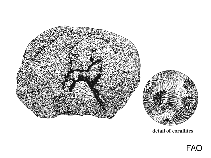Leptastrea bottae (Milne-Edwards & Haime, 1849)
| Native range | All suitable habitat | Point map | Year 2050 |

|
| This map was computer-generated and has not yet been reviewed. |
| Leptastrea bottae AquaMaps Data sources: GBIF OBIS |
Google image | No image available for this species;
drawing shows typical species in Faviidae.
Classification / Names Populärnamn | synonymer | CoL | ITIS | WoRMS
Hexacorallia | Scleractinia | Faviidae
Environment: milieu / climate zone / djupintervall / distribution range Ekologi
Revassocierade; djupintervall 0 - 40 m (Ref. 848). Tropical; 30°N - 27°S, 32°E - 137°W (Ref. 848)
Distribution Länder | FAO områden | Ekosystem | Förekomster | Utplanteringar
Indo-Pacific: Red Sea to Australia and Mozambique to Tahiti.
Length at first maturity / Size / Weight / Age
Könsmognad: Lm ? range ? - ? cm
Life cycle and mating behavior Könsmognad | Reproduktion | Lek | Eggs | Fecundity | Larvae
Main reference
referenser | Koordinator | Medarbetare
Veron, J.E.N. 2000. (Ref. 848)
IUCN Red List Status
(Ref. 130435: Version 2024-2)
CITES status (Ref. 108899)
CMS (Ref. 116361)
Threat to humans
Human uses
| FishSource |
Verktyg
Ytterligare information
Födosammansättning
Födointag
Predatorer
Max. ages / sizes
Length-weight rel.
Length-length rel.
Length-frequencies
Mass conversion
Abundans
Internet-källor
BHL | BOLD Systems | CISTI | DiscoverLife | FAO(Publication : search) | Fishipedia | GenBank (genome, nucleotide) | GloBI | Gomexsi | Google Books | Google Scholar | Google | PubMed | Tree of Life | Wikipedia (Go, sök) | Zoological Record



